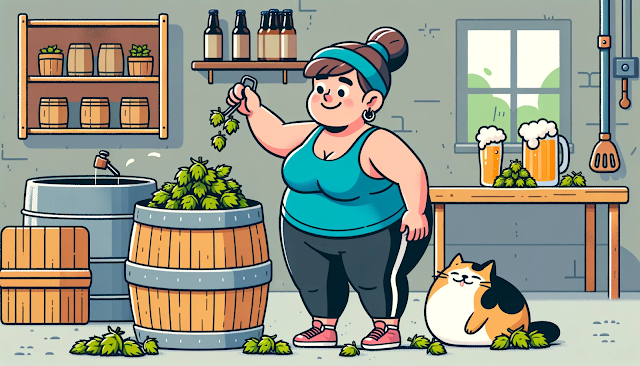The Brewer's Guide to a Creamier, Smoother Beer
For brewers of every stripe, from the weekend hobbyist to the seasoned professional, the quest for the perfect pint is a constant pursuit. While aroma and flavour often take centre stage, the secret to a truly unforgettable beer often lies in its texture. A velvety, creamy mouthfeel can elevate a good beer to a great one, transforming each sip into a luxurious experience.Before we dive into the techniques, let's establish our benchmark. If you’ve ever enjoyed the cascading pour of a Kilkenny or a Guinness Draught, you know the gold standard of creamy. A key reason for their signature texture is the innovative blend of carbon dioxide and nitrogen used for carbonation, a topic we'll explore later.

Master Your Grains for a Fuller Body
The foundation of your beer's body is the malt bill. Beyond dictating colour and flavour, malts are your primary tool for building viscosity and richness. By carefully selecting your grains and adjusting your process, you can create a beer with a substantial, silky texture.
1. Boost Your Grain Bill and Specialty Malts
The most direct path to a fuller body is increasing the overall grain bill. This raises the original gravity, leaving behind more unfermentable sugars and proteins. Incorporate malts known for adding body, such as Munich or Vienna Malt. For a pronounced effect, Caramel/Crystal Malts (e.g., Carapils, Caramel 60L) are excellent choices, contributing dextrins that enhance mouthfeel and head retention.
2. Harness the Power of Flaked Grains
For a truly silky, velvety texture, look no further than flaked grains. Flaked Oats are a brewer's favourite for their high content of beta-glucans, which add significant viscosity without fermenting. They are the signature ingredient in Oatmeal Stouts and a cornerstone of hazy New England IPAs. Similarly, Flaked Wheat and Flaked Barley contribute proteins that result in a fuller, rounder mouthfeel and improved head stability.
Brewer's Tip: When using flaked grains, aim for 5-20% of your total grist. Add them directly to the mash with your base malts. Be mindful that higher percentages can lead to a "stuck mash," so incorporating rice hulls can help maintain good lauterability.
3. Control Your Mash Temperature
Your mash temperature is a powerful lever for controlling fermentability. Mashing at a higher temperature, typically between 69-70°C (156-158°F), favours the enzyme alpha-amylase. This produces longer-chain, less fermentable sugars (dextrins) that remain in the final beer, contributing directly to a fuller, sweeter, and more viscous body. A lower mash temperature (around 65°C / 149°F) favours beta-amylase, creating a drier, thinner beer.
4. Don't Forget Water Chemistry
The mineral profile of your brewing water has a subtle but significant impact. To accentuate a soft, full mouthfeel, aim for a higher chloride-to-sulfate ratio. A ratio of 2:1 (e.g., 100 ppm Chloride to 50 ppm Sulfate) can enhance the perception of maltiness and fullness, making it ideal for styles like stouts and hazy IPAs. Conversely, a higher sulfate content accentuates hop bitterness and creates a drier finish.
The Sweet Secret: Brewing with Lactose
Lactose, or milk sugar, is a unique tool in the brewer's arsenal. Unlike maltose, standard brewing yeast cannot ferment it. This means it remains in the finished beer, imparting a distinct sweetness and a significant boost to the body and creamy texture. It's the defining ingredient in styles like Milk Stouts and is increasingly popular in fruit-forward Milkshake IPAs.
To use lactose, add it during the last 10-15 minutes of the boil to ensure it is fully dissolved and sanitized. A typical starting dosage is 120-240 grams per 19-litre (5-gallon) batch. Be judicious; its sweetness can easily overpower a beer's profile if overused.
It's best suited to dark, robust styles or intentionally sweet IPAs where its character can shine.
Important Note: Always remember that lactose is a dairy derivative. If you are brewing for friends or sharing your beer, be sure to clearly label it as containing lactose for those with allergies or intolerances.
Leverage Hops for Lasting Head Retention
While we primarily associate hops with bitterness and aroma, they play a crucial role in foam stability. The alpha acids in hops transform into isohumulones during the boil. These compounds interact with proteins in the beer, creating a strong network that forms stable, long-lasting bubbles. A thick, persistent head contributes significantly to the perception of a creamy mouthfeel.
Hops with a higher alpha-acid content, such as Chinook, Columbus, or Simcoe, are particularly effective. While a strong bittering addition at the start of the boil is key, late-boil or whirlpool hop additions also contribute foam-positive compounds without adding excessive bitterness. For styles where you want a creamy head without overwhelming bitterness, consider using hops high in alpha acids in smaller, later additions.

The Ultimate Creaminess: The Nitro Pour
To truly replicate the iconic creaminess of a Guinness, you must venture into the world of nitrogenation. Serving beer on a nitrogen/CO2 blend (typically 70% nitrogen, 30% CO2) creates incredibly small, stable bubbles. Because nitrogen is largely insoluble in liquid, it produces a thick, creamy, and remarkably stable head, leading to that signature velvety mouthfeel.
This advanced technique requires specialized equipment, including a nitrogen gas tank, a specific regulator, and a stout faucet (which contains a restrictor plate to force the beer through tiny holes, knocking the nitrogen out of solution). While it represents an investment, the result is a truly professional and unparalleled creamy texture that is impossible to achieve with CO2 alone.
A Final Word of Caution
While chasing the perfect creamy texture, it's vital to stick to proven brewing ingredients. A common question from beginners is whether adding actual dairy cream is a viable shortcut. The answer is a resounding no. The fats in cream will wreck your beer's head retention, can quickly turn rancid, and introduce a high risk of bacterial contamination.
Achieving that dreamy, creamy mouthfeel is well within your grasp. By thoughtfully building your grain bill, mastering your mash, and perhaps experimenting with adjuncts like lactose or even a nitrogen setup, you can craft a beer that feels as incredible as it tastes.














